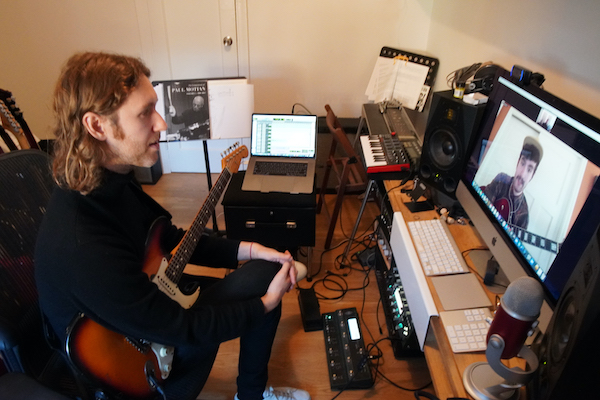Oct 28, 2025 10:47 AM
In Memoriam: Jack DeJohnette, 1942–2025
Jack DeJohnette, a bold and resourceful drummer and NEA Jazz Master who forged a unique vocabulary on the kit over his…

Guitarist Nir Felder (left), a faculty member at The New School, delivers online instruction to student Evan Macaluso.
(Photo: Courtesy Nir Felder)For jazz students enrolled in fall classes at The New School in New York City, the “new normal” during the pandemic meant that all instructional activity took place online.
To help students get the maximum benefit from their classes, administrators realized that the first step was to ensure that everyone had the proper equipment.
“The New School recognized that not every student was going to have the hardware, software or internet connection that they might need to succeed,” Keller Coker, dean of the institution’s School of Jazz and Contemporary Music, said via Zoom in November. “Every single registered student—part-time or full-time—was given a technology grant on the first day of school. It was $500 to cover a USB microphone, a piece of software, a better internet connection, whatever they needed. It was $500 transferred directly to their account.
“Students had their syllabi beforehand, and the faculty made sure to identify [the equipment required for each course]. Because of that communication, all students essentially had what they needed by the end of the first week.”
This fall, guitarist Nir Felder and saxophonist Jane Ira Bloom both taught five-week courses called Recording Combo Modules. Felder has helped student musicians learn skills that they can apply to real-world situations following graduation.
“The New School has provided a browser-based platform called Soundtrap, which students can record with, which is great,” Felder said via videoconference. “But a lot of my students are more advanced, and they want to learn [additional] real-world applications, like Pro Tools, Logic and Ableton. We’ve been mainly working in Pro Tools, and students are so excited to learn about how to better record themselves.
“I open up Pro Tools on my computer and I share my screen. I can show them directly how to edit something, how to use a plug-in and how change different sounds. It’s really helpful for them to see it on their screen. If they have a question, I can show them how to do it right away, instead of them, you know, watching a 20-minute YouTube tutorial to find the one thing that they can’t figure out. So, [the class] is very hands-on.”
Coker is a firm believer that in addition to learning musical chops, students should gain technological skills, too: “We had forums with students and faculty, and I asked our faculty members, ‘How much of your living do you make doing the kind of thing we’re about to do during this pandemic?’ And several of them said, ‘Oh, that is how I make the majority of my money. I make it online, doing online lessons, [recording] single tracks, and doing networked recording.’”
Bloom explained that she wants students to embrace the technology that allows them to layer individual instrumental parts into an ensemble recording; however, she also encourages them to not lose sight of the unpredictable, improvisational aspects of making music.
“A lot of times, students are so caught up in the technology of the recording—the oddness of living in a set of headphones—that when we revisit their compositions, [our goal is to figure out] how to get the humanity back in the tracks,” she said. “We [discuss] how to push air molecules through a microphone, how to expand your emotional range in a new recorded world, so that the microphone picks up what you mean. Students are thinking about things like that. And sometimes they even put asymmetry back into their playing, so that it feels human again, as opposed to metric.”
Among the other world-class jazz artists on the faculty are drummer Matt Wilson and trumpeter Dave Douglas. Both musicians helped their students to record, mix and master an entire album during a five-week module.
“It’s incredibly meaningful, the connection between mentors and students right now,” Bloom said. “There’s a heightened sense of commitment and responsibility, because we need our music, and we need to talk about it, and we need to make it together. Our imagination and creativity are so important to the students right now. You just want to give it your all, because you can sense the need is there.” DB
This story originally was published in the February 2021 issue of DownBeat. Subscribe here.

Jack DeJohnette boasted a musical resume that was as long as it was fearsome.
Oct 28, 2025 10:47 AM
Jack DeJohnette, a bold and resourceful drummer and NEA Jazz Master who forged a unique vocabulary on the kit over his…

D’Angelo achieved commercial and critical success experimenting with a fusion of jazz, funk, soul, R&B and hip-hop.
Oct 14, 2025 1:47 PM
D’Angelo, a Grammy-winning R&B and neo-soul singer, guitarist and pianist who exerted a profound influence on 21st…

Kandace Springs channeled Shirley Horn’s deliberate phrasing and sublime self-accompaniment during her set at this year’s Pittsburgh International Jazz Festival.
Sep 30, 2025 12:28 PM
Janis Burley, the Pittsburgh International Jazz Festival’s founder and artistic director, did not, as might be…

Jim McNeely’s singular body of work had a profound and lasting influence on many of today’s top jazz composers in the U.S. and in Europe.
Oct 7, 2025 3:40 PM
Pianist Jim McNeely, one of the most distinguished large ensemble jazz composers of his generation, died Sept. 26 at…

Drummond was cherished by generations of mainstream jazz listeners and bandleaders for his authoritative tonal presence, a defining quality of his style most apparent when he played his instrument unamplified.
Nov 4, 2025 11:39 AM
Ray Drummond, a first-call bassist who appeared on hundreds of albums as a sideman for some of the top names in jazz…